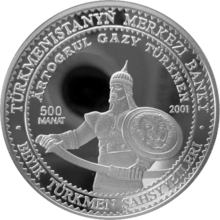Kayı (tribe)
The Kayı or Kai tribe (Turkish: Kayı boyu) were an Oghuz Turkic people and a sub-branch of the Bozok tribal federation. In the 11th century Mahmud al-Kashgari cited Kayı (Kayığlardır) as of one of 22 Oghuz tribes in his Dīwān Lughāt al-Turk. The word kayı means "the one who has might and power by relationship".
Kayı | |
|---|---|
 | |
| Regions with significant populations | |
| Turkey | |
| Languages | |
| Turkish | |
| Religion | |
| Islam | |
| Related ethnic groups | |
| Oghuz Turks |
Origin
In his history work Shajare-i Tarakime, the khan of the Khanate of Khiva and historian, Abu al-Ghazi Bahadur, mentions Kayı among 24 Oghuz Turkic tribes, direct descendants of Oghuz-khan, who was the ancient progenitor of the Oghuz people. The name of the tribe translates as “strong”. In his extensive history work “Jami' al-tawarikh” (Collection of Chronicles), the statesman and historian of the Ilkhanate Rashid-al-Din Hamadani also says that the Kayı tribe comes from the oldest of Oghuz Khan's 24 grandchildren who were the patriarchs of the ancient Oghuz tribes, and the name Kayı means “powerful”.
History

According to Ottoman tradition, Osman I, the founder of Ottoman Empire, was a descendent of the Kayı tribe.[1][2][3][4] This claim has, however, been called into serious question by many modern historians. The only evidence for the Ottomans' Kayı descent came from genealogies written during the fifteenth century, more than a hundred years after the life of Osman. More significantly, the earliest genealogies written by the Ottomans did not include any reference to Kayı descent at all, indicating that it may have been fabricated at a later date.[5]

The famous Oghuz Turkish folk narrator, soothsayer and bard Gorkut-ata (Dede Korkut) belonged to the Kayı tribe . In the 10th century, the Central Asian Oghuz Yabgu State was headed by supreme leaders (or Yabghu) who belonged to the Kayi tribe[6].
In the Middle Ages, part of the Kayi tribe moved from Central Asia to what is now Ukraine, they are known in the Old Russian Chronicles as kovuy and kaepichi[7]. According to the famous Soviet and Russian linguist and turkologist A. V. Superanskaya, the origin of the name of the city of Kiev is associated with the Kayı tribe: "As ethnographers testify, ethnically “pure” peoples do not and cannot exist. On the contrary, new peoples arise from ethnic mixes of two or more peoples, usually assimilating the best features of each. There are many folk legends that the beginning of a nation was laid by two (or several) brothers ... Apparently, something similar lies behind the legend of Kiy, Schek, Horev and Lybed. The tribal name Kyy (Kiy) belonged to the ancient Turkic peoples. It is still present in the names of tribal structures of modern Turkic peoples ”.
The Kayı tribe were the founders of such medieval Anatolian Beyliks as İsfendiyaroğulları and Çobanoğulları.
With the Russified name Kaitag (Mountain Kayı) the Kayı tribe played a prominent role in the history of the Caucasus, and now the Kaitag language is classified as one of five dialects of the Kumyk language, which for ten centuries (10–19 cc.) was a lingua franca in the North Caucasus. Kaitag principality was a leading component of the Shamkhalate of Kazi-Kumukh state on the Caspian western seaboard that in different forms lasted from the 8th to the 19th centuries. Kaitag textiles, stamped out under the Soviet rule, remain distinct in their artistry and workmanship.
Kayı Tribe in Modern Times
In Anatolia, twenty seven villages bear the name of Kayı.[8]
In Turkmenistan, the Kayı tribe is one of the main divisions of the Geklen Turkmens living in the Balkan region and consists of the following clans: adnakel, ak kel, alatelpek, bagly, barak, burkaz, ganjyk, gapan, garabalkan, garawul, garagol, garagul, garadaşly, garakel, garga, garyşmaz and others. The Kayı are also a clan among the Bayat Turkmens of the Lebap Region[9]
Interesting Facts
The name and logo of the İYİ Party (means Good in Turkish) of Meral Akşener is inspired by the seal of the Kayı tribe.[10]
See also
- Ottoman Dynasty
- Ertuğrul
- Turkmen Tribes
- Halime Hatun
- Dündar Bey
- Hayme Hatun
- Suleyman Shah
- Oghuz traditional tribal organization
- Kaza-i Cuma (or Kayılar Kazası)
Notes
- "Some Ottoman genealogies claim, perhaps fancifully, descent from Kayı.", Carter Vaughn Findley, The Turks in World History, pp. 50, 2005, Oxford University Press; Shaw, Stanford Jay. History of the Ottoman Empire and Modern Turkey. Cambridge University Press, 1976, p. 306
- "Ottoman Empire". Britannica Online Encyclopedia. Retrieved 11 February 2013.
- Atalay, Besim (2006). Divanü Lügati't - Türk. Ankara: Türk Tarih Kurumu Basımevi. ISBN 975-16-0405-2, Cilt I, sayfa 55.
- Golden, Peter B. (1992). An Introduction to the History of the Turkic People. Otto Harrassowitz, Wiesbaden. p. 358, 359
-
Kafadar, Cemal (1995). Between Two Worlds: The Construction of the Ottoman State. p. 122.
That they hailed from the Kayı branch of the Oğuz confederacy seems to be a creative "rediscovery" in the genealogical concoction of the fifteenth century. It is missing not only in Ahmedi but also, and more importantly, in the Yahşi Fakih-Aşıkpaşazade narrative, which gives its own version of an elaborate genealogical family tree going back to Noah. If there was a particularly significant claim to Kayı lineage, it is hard to imagine that Yahşi Fakih would not have heard of it.
- Lowry, Heath (2003). The Nature of the Early Ottoman State. SUNY Press. p. 78. ISBN 0-7914-5636-6.
Based on these charters, all of which were drawn up between 1324 and 1360 (almost one hundred fifty years prior to the emergence of the Ottoman dynastic myth identifying them as members of the Kayı branch of the Oguz federation of Turkish tribes), we may posit that...
- Lindner, Rudi Paul (1983). Nomads and Ottomans in Medieval Anatolia. Indiana University Press. p. 10.
In fact, no matter how one were to try, the sources simply do not allow the recovery of a family tree linking the antecedents of Osman to the Kayı of the Oğuz tribe.
- Lowry, Heath (2003). The Nature of the Early Ottoman State. SUNY Press. p. 78. ISBN 0-7914-5636-6.
- Росляков (Roslyakov), А. (A.) (1956). "Краткий очерк истории Туркменистана (до присоединения к России)" [A Brief Outline of the History of Turkmenistan (before accession to Russia)] (in Russian). Ashgabat, Turkmenistan: Turkmegosizdat. p. 70.
- Толстов (Tolstov), Сергей (Sergey) (1947). "Города Гузов (историко-этнографические этюды)" [The Cities of the Ghuz (historical and ethnographic studies)] (in Russian). Moscow: Soviet Ethnography Journal.
- Еремеев (Yeremeyev), Дмитрий (Dmitriy) (1971). "Этногенез турок (Ethnogenesis of the Turks)". Google Books.
- Atanyýazov, Soltansha (1988). "Словарь туркменских этнонимов" [Dictionary of Turkmen Ethnonyms] (in Russian).
- "The bow and two arrows". Hürriyet Daily News. Retrieved 2020-06-07.
References
- Kafesoğlu, İbrahim. Türk Milli Kültürü. Türk Kültürünü Araştırma Enstitüsü, 1977. page 134
- Gmyrya, L. 1995. "Hun country at the Caspian Gate: Caspian Dagestan during the epoch of the Great Movement of Peoples". Makhachkala: Dagestan Publishing